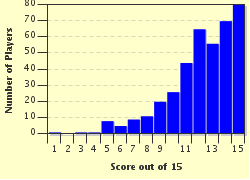Quiz Answer Key and Fun Facts
1. Thanksgiving Day begins with a "T"! But I'm vegetarian; no turkey for me. Instead I'll nosh tofu and not make a scene, but what does "tofu" actually mean?
2. Thanksgiving has "H" as its second letter, and some good vegetables would serve us better. In French they call them haricots verts, but can you tell me, in English, what veggies are there?
3. A is for autumn in the temperate climes, as we turn back our clocks with the changing times. But in North America, for some obscure reason, what word is used for the autumnal season?
4. As a moveable feast, Thanksgiving is fine. Canadians get October, but Yanks wait to dine. In 1941, U.S. Congress set the feast on the 4th Thursday of what month (in the USA, at least)?
5. For Thanksgiving dinner we might have kale, or spinach, or chard - any greens on sale. What element called "K" is in sun-dried tomatoes, greens, mushrooms, asparagus, and baked sweet potatoes?
6. Thanksgiving's "S" marks a seven-day feast that goes centuries back in the old Middle East. Look at Leviticus 23, gather a fruit and branches three, camp out in a sukkah! What feast could this be?
7. The first "G" in Thanksgiving is for gravy, of course. What basic ingredients go in this sauce?
8. The first "I" in Thanksgiving is for Indian corn, an important food when Thanksgiving was born. The Iroquois named maize one of sisters three. What could the other two sisters be?
9. "V" is the ninth letter in "Thanksgiving Day", but vegetables have already come into play. Venison was probably the Pilgrims' meat. What animals were they having to eat?
10. The next letter in "Thanksgiving Day" is "I" so we will enjoy our isquotm squash (askutasquash) pie. We'll scoop it out, put honey, milk, and spice in. Cook on the fire, then eating WHAT will begin?
11. Thanksgiving! And pie with the family, my dear! Look out for squirrels, 'cause the NUTS are all here! Some say "PEE-can" and some say "puh-CAHN". In what language does "pecan" mean "crack this nut with a stone"?
12. "Some hae meat and canna eat, / And some wad eat that want it, / But we hae meat and we can eat, / And sae the Lord be thankit." On Thanksgiving Day, many families say grace. This blessing of food (above) comes from what place?
13. For Thanksgiving, we eat as much as we're able. What word comes from the French, and means "to clear the table"?
14. Thanksgiving desserts are so yummy and nice, it's not out of order to mention them twice. "A" is for "afters" in some British lore. What's a generic dessert word, if (in England) you'd like sweets once more?
15. When Thanksgiving is over, Advent is near, and Christmas, then New Year's Eve round out the year. With a log in the fire, we'll be decking the hall. What's the name of the old midwinter festival?
Source: Author
nannywoo
This quiz was reviewed by FunTrivia editor
stedman before going online.
Any errors found in FunTrivia content are routinely corrected through our feedback system.

